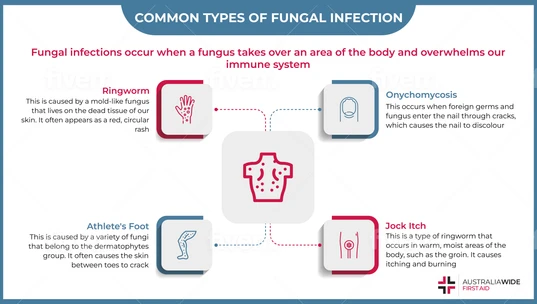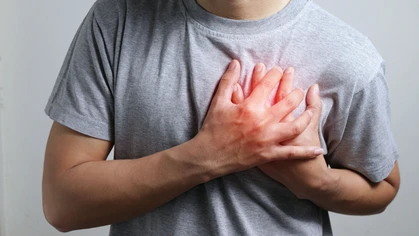Common Types of Fungal Infection

Disease

Fungal infections occur when an invading fungus takes over an area of the body and overwhelms the immune system. Today, we look at the most common types of fungal infection, and how to stop them from interfering with your daily life.
There are millions of fungus species living all around us – in the soil, on plants, on our table surfaces, and even inside our body. Most fungus species are harmless, however, there are a few hundred of them that can make us sick.Fungal Infections: What Are They?
Fungal infections can affect anyone and everyone. They occur when an invading fungus takes over an area of the body and proves to be too much for our immune systems to handle. They can be difficult to kill as re-infection is a possibility and many fungi are notoriously persistent. However, not all fungi are harmful. Fungi such as mushrooms are mostly harmless, edible, and tasty. Other types of fungi, like aspergillus, can be extremely dangerous and may lead to life-threatening diseases. Different types of fungi can lead to different fungal infections. Fungi that are not typically found on or inside the human body can colonise it, causing an infection. In other cases, fungi that are normally present on or inside the body can multiple out of control and cause an infection. Most infections are contagious and can be spread from one person to another. In this article, let’s go through some of the most common fungal infections that you may have heard about or may have experienced first-hand.Thrush
Thrush is a common fungal infection caused by a type of fungus called Candida albicans. While this fungus is a natural resident in our body, circumstances such as poor hygiene and a warm environment can cause the fungus to grow faster than our immune system’s ability to keep it in check. The overgrowth of this fungus can cause painful symptoms such as:- Itching and irritation of the vagina and penis head,
- White or yellow discharge,
- Discomfort during sexual activities, and
- Stinging when urinating.
Athlete's Foot
Athlete’s foot is a common fungal infection that usually grows in between the toes and is caused by a variety of fungi belonging to a group called dermatophytes. This fungal infection commonly occurs in people whose feet have become very sweaty while being confined in tight-fitting shoes. This fungus thrives in closed, warm and moist conditions as they feed on the proteins found in hair, nails and skin – making the inside of your shoes the ideal environment. Symptoms include:- Peeling or cracked skin between the toes,
- Itchiness – especially right after taking off shoes and socks,
- Burning or stinging in the infected area, or
- Inflamed skin that may appear reddish, purplish, or greyish depending on your skin colour.
Jock Itch
Jock itch is a fungal infection that causes a red and itchy rash on warm, moist areas of the body. It’s a form of ringworm that often affects the groin, inner thighs and is shaped like a ring. Jock itch gets its name because it’s common in athletes as people who sweat a lot are more likely to get infected. Others who are overweight or suffer from eczema are also at risk of being infected with jock itch. Common symptoms of jock itch include:- Itching and burning,
- A red, scaly and circular rash with raised edges, and
- Cracking or peeling skin.
Ringworm
Known as a common infection on the skin, ringworm is a fungal infection that appears as a circular rash (shaped like a ring) and is usually red and itchy. It’s caused by a mold-like fungi that lives on the dead tissues of your skin, hair, and nails. It’s possible to get ringworm anywhere on your body from in between your toes to the top of your scalp. If it spreads to the groin, this can be known as jock itch. Some common symptoms of ringworm include:- A circular rash typically near the buttocks, arms, and legs,
- Itchiness and discomfort,
- A clear or scaly area inside the ring,
- Scattering bumps within the ring itself,
- A flat patch of itchy skin, and
- Overlapping rings.
Onychomycosis
Onychomycosis, also known as nail fungus, is a fungal infection that causes your nails to discolour and causing the edges to thicken and crumble. This fungal infection mainly occurs when foreign germs and fungus enter your nail through small cracks or cuts in the nail. This common infection begins as a white or yellow spot under the tip of the nail. As the fungal infection goes deeper, this will cause the typical discolouration and brittle qualities associated with onychomycosis. Other noticeable symptoms include:- Foul smelling nails,
- Distorted nail shape,
- Dark coloured nails – caused by debris building up under the nail, and
- A thickened nail.
- Avoiding going barefoot in communal areas,
- Cleaning your nail trimmers before and after use,
- Keeping your feet dry, and
- Wearing correctly fitted shoes.
Conclusion
While there are all sorts of fungal infections that may cause harm to us, many of these can be easily treated with the right medication. It’s important to always keep clean and to be wary if you notice any symptoms. To learn more about identifying, managing, and preventing the symptoms of various health conditions, book a First Aid course with us today.
Originally published at
https://www.australiawidefirstaid.com.au/resources/common-types-of-fungal-infection
as part of the Australia Wide First Aid Articles Library









